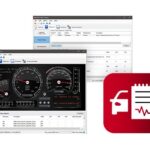Converting your older vehicle to OBD2 (On-Board Diagnostics II) offers significant advantages, especially when it comes to engine diagnostics and tuning. While direct flashing for performance gains isn’t as straightforward as on some platforms, there are effective methods to achieve OBD2 compatibility. This guide explores the available options for Obd2 Conversion, focusing on logging and tuning capabilities for your vehicle.
For those primarily interested in data logging, the BlackStealth MUT to OBD2 CANBUS converter presents a viable solution. This device bridges the gap between your older car’s MUT (Mitsubishi Unified Transfer) system and modern OBD2 protocols. By simply plugging in this converter, you can access OBD2 output, enabling real-time data logging using popular Android/iOS apps like Torque. Furthermore, the BlackStealth converter accommodates additional inputs for external sensors like wideband air-fuel ratio and boost pressure, expanding your monitoring capabilities. While tuning with this setup is limited to piggyback systems, significant performance enhancements can still be achieved.
If your goal extends beyond logging to include comprehensive tuning, two primary paths emerge: utilizing a Chrome ECU or performing a ’99 ECU swap. The Chrome ECU, available from 3SX, offers a user-friendly, plug-and-play solution for OBD2 logging and tuning. Pre-configured for your specific vehicle, the Chrome ECU simplifies the conversion process. Alternatively, a ’99 ECU swap, requiring a custom wiring harness, provides similar OBD2 functionality. While potentially more cost-effective if you can source parts and handle the wiring yourself, the ’99 retrofit demands more technical expertise and patience. Regardless of the chosen ECU, implementing Chrome firmware unlocks advanced tuning capabilities far beyond the scope of basic piggyback systems. This includes features like launch control, ECU-controlled boost, and support for larger fuel injectors for E85 compatibility, alongside the inherent safety features of the stock ECU.
To effectively utilize these OBD2 conversion methods for tuning and diagnostics, certain tools are necessary. For data logging, software like EvoScan (for PC) or the BlackStealth converter (with mobile apps) is essential. Tuning with ECUflash requires a laptop PC and an Openport 2.0 cable. Unless you opt for professional dyno or street tuning services, you’ll be navigating the tuning process independently. While the initial learning curve can be steep for those new to ECU tuning, abundant resources are readily accessible. Guides like the one on 3SGTO, created by the developer of Chrome, alongside valuable information from the Evo community and Merlin’s Flash Guide, provide comprehensive support.
In conclusion, OBD2 conversion for older cars offers valuable diagnostic and tuning benefits. Whether you choose a simple MUT to OBD2 converter for logging or opt for a Chrome ECU or ’99 ECU swap for full tuning capabilities, the path to modern engine management is accessible. While self-tuning requires dedication and learning, the wealth of available information empowers enthusiasts to unlock the full potential of their vehicles.
